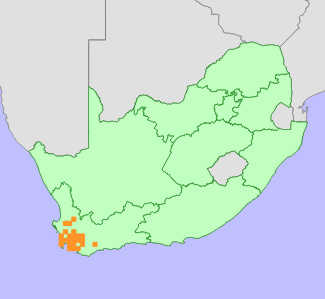|
Scientific Name | Thamnochortus sporadicus Pillans |
Higher Classification | Monocotyledons |
Family | RESTIONACEAE |
Synonyms | Thamnochortus muticus Pillans, Thamnochortus piketbergensis Pillans, Thamnochortus similis Pillans |
National Status |
Status and Criteria | Least Concern |
Assessment Date | 2020/03/03 |
Assessor(s) | L. von Staden |
Justification | Thamnochortus sporadicus is a widespread, but rare and localized habitat specialist. It is declining in parts of its range, but not yet in danger of extinction. It has an extent of occurrence (EOO) of 22 468 km², and is listed as Least Concern. |
Distribution |
Endemism | South African endemic |
Provincial distribution | Western Cape |
Range | This species is endemic to the Western Cape, South Africa, where it occurs from Piketberg to the Cape Peninsula and Riviersonderend Mountains. |
Habitat and Ecology |
Major system | Terrestrial |
Major habitats | Breede Alluvium Fynbos, Swartland Alluvium Fynbos, Lourensford Alluvium Fynbos, Cape Flats Sand Fynbos, Kogelberg Sandstone Fynbos, Swellendam Silcrete Fynbos, Leipoldtville Sand Fynbos, Atlantis Sand Fynbos, Hangklip Sand Fynbos, Cape Lowland Alluvial Vegetation, Hawequas Sandstone Fynbos, Breede Alluvium Renosterveld, Overberg Sandstone Fynbos, North Sonderend Sandstone Fynbos, South Sonderend Sandstone Fynbos, Graafwater Sandstone Fynbos, Olifants Sandstone Fynbos, Winterhoek Sandstone Fynbos, Piketberg Sandstone Fynbos, South Hex Sandstone Fynbos, Peninsula Sandstone Fynbos, Breede Sand Fynbos |
Description | It occurs on alluvial flats, particularly along the base of mountains, or on sandy valleys on lower montane plateaux, with isolated records from lower clay slopes. |
Threats |
| Thamnochortus sporadicus has lost habitat on the Western Cape's coastal lowlands due to habitat loss to agriculture and urban expansion, and loss continues. Subpopulations in the mountains are generally not threatened, except within the Hawequas, Franschhoek and Riviersonderend Mountains, where there are uncontrolled alien invasive plants outcompeting native species. |
Population |
This species occurs as isolated plants, and does not form dense stands (Linder 2011). It is suspected to be declining due to ongoing habitat loss.
|
Population trend | Decreasing |
Assessment History |
Taxon assessed |
Status and Criteria |
Citation/Red List version | | Thamnochortus sporadicus Pillans | Least Concern | Raimondo et al. (2009) | |
Bibliography |
Goldblatt, P. and Manning, J.C. 2000. Cape Plants: A conspectus of the Cape Flora of South Africa. Strelitzia 9. National Botanical Institute, Cape Town.
Linder, H.P. 2011. The African Restionaceae: an Interactive Key identification and description system. Version 6. http://www.systbot.uzh.ch/Bestimmungsschluessel/Restionaceae_en.html. Downloaded.
Manning, J.C. and Goldblatt, P. 2012. Plants of the Greater Cape Floristic Region 1: The Core Cape Flora. Strelitzia 29. South African National Biodiversity Institute, Pretoria.
Raimondo, D., von Staden, L., Foden, W., Victor, J.E., Helme, N.A., Turner, R.C., Kamundi, D.A. and Manyama, P.A. 2009. Red List of South African Plants. Strelitzia 25. South African National Biodiversity Institute, Pretoria.
|
Citation |
| von Staden, L. 2020. Thamnochortus sporadicus Pillans. National Assessment: Red List of South African Plants version 2024.1. Accessed on 2025/11/17 |
 Comment on this assessment
Comment on this assessment


